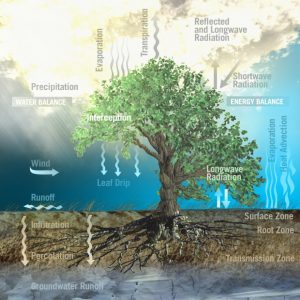10. Evaporation and Wind Erosion
Thus far we have studied the spatial patterns and organization of soils across multiple spatial scales, and we have examined how soils interact with water balance processes such as precipitation, rainfall interception, raindrop impact, infiltration, runoff, water erosion, soil water redistribution, drainage, solute transport, and groundwater pollution. Now, we are ready to move toward the right hand side of Fig. 10‑1 to consider the processes connected to the energy balance at the land surface.

In this chapter, we will focus on the process of evaporation. In this context, evaporation is the process in which water changes phase from liquid to vapor and is transported to the atmosphere from one of the following sources:
- the soil,
- the exterior surface of plants,
- plant residue, or
- surface water bodies.
Defined in this way, evaporation is distinct from the process of transpiration, which is the vaporization of water from the interior of plants, predominantly exiting through the stomates. The above definition also distinguishes evaporation from the composite process called evapotranspiration, which is simply the sum of evaporation and transpiration for a specified region of the Earth’s surface.

